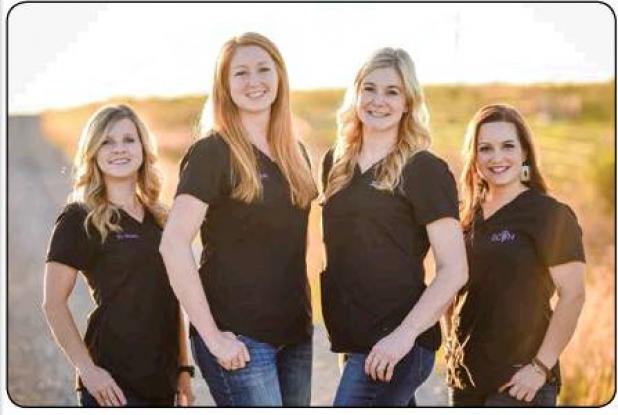

The Doctor Is In, Olney: Salt Creek Veterinary Hospital
In rural areas, veterinarians are rareespecially those who treat large animals according to the American Veterinary Medical Association (AVMA). The AVMA study indicates that 63 Texas counties in remote areas have only one veterinarian available to treat farm and ranch animals. However, in Olney, we are lucky to have four veterinarians at Salt Creek Veterinary Hospital who are not only licensed to care for domestic animals but also trained to care for the health and well-being of livestock.
Dr. Keelan Lewisthe owner of Salt Creek Veterinary Hospitalpurchased the clinic from her dad Arn Anderson in 2014. “I came here [Olney] right out of school after swearing I would never be a vet because my dad is a vet. In college, I decided that I wanted to become a vet in 2011.”
After purchasing the clinic, Lewis said they started expanding to other local towns. Multiple locations practicing a vast range of animalcare services is a massive win for Olney and the surrounding areas since there will be a national shortage of approximately 15,000 veterinarians by the year 2025 with the bulk of the deficit in rural areas according to a study by the U. S. Census bureau. Currently, there are five locations in Texas: Countryside Veterinary Hospital in Graham, Cross Timbers Veterinary Hospital in Bowie and Nocona and Salt Creek Veterinary Hospital in Olney and Seymour.
Lewis speaks highly of the all-female staff of doctors she has hired. Ironically, all the doctors she hired graduated from Texas A & M University College of Veterinary Medicine, where women make up 75 percent of the university’s graduating veterinarian class. “We foster a female environment and our clientele expect to see a female doctor when they come in,” Lewis said. “Veterinary medicine is a male-dominated profession in rural areas. My father and I encourage young female veterinarians to enter rural medicine because it is still alive, and you can practice good medicine in small towns.”
Dr. Carrie Foltyn was the first doctor hired in 2016. Foltyn said, “I found out about Salt Creek through an externship. I was intrigued, so I came here, and Keelan offered me a job.”
Lewis joked, “I did not want to let her [Foltyn] leave because I thought she would never come back.”
Dr. Brittany Thompson was the next doctor who joined the team. Thompson said, “During my third year of school, Dr. Keelan made a presentation to our production medicine class. I remember sitting in class and thinking to myself that I want to be like her when I grow up. And then I realized I am already an adult,” she joked. “After my professor helped me secure an interview, I knew Salt Creek is the place I wanted to be.”
The most recent hire, Dr. Amy Eiland, joined the Salt Creek team in 2018. “I got involved through school, which is how I met Dr. Keelan’s dad. The school was starting a new track that allowed students an opportunity to select the patients you’re interested in; I was interested in Food/Animal science, and that led to an externship with Dr. Anderson. When I was on that externship, with Dr. Anderson, Dr. Keelan stole me away from him, which was wonderful.” Both provided mentorship, and with me being close to family, my husband and I agreed that [Salt Creek] was the place to be.”
All the doctors said they enjoy coming to work and they enjoy working with one another. Foltyn chimed in, “The light at the end of the tunnel does exist when you have a group of people you can work with.”
Even with a reliable staff of credentialed doctors on call 24 hours a day, seven days a week, rural veterinary clinics in small towns across the nation are struggling to compete with the low-cost grant-funded nonprofit clinics that are moving into rural communities. Lewis gave the following example to emphasize the impact this trend has on veterinary care in our rural community.
Lewis said, “It would be like me shopping at Stewart’s, which is exceptional. I can go there to purchase hamburger meat, prime rib, or I can get a specialty prime rib cut for my whole family. What low-cost vet clinics do, is take away all the hamburger meat, leaving no base for our business [Salt Creek] to provide prime rib. I pay for vets to take their turn being available all the time. If we no longer have our base of giving vaccinations, spaying and neutering, then we can’t pay for vets to be available all the time; and we can’t provide the high-quality care because there is no base.”
Lewis said these clinics provide services at a cheaper rate partly because grants fund them, and because they are nonprofit, they are exempt from paying taxes. “The majority of them [clinics] are from cities, and they come into rural communities attempting to be philanthropic by helping people they believe are incapable of taking care of themselves, which is exactly against what we feel about a small town. We believe we can take care of ourselves, and we can provide for ourselves, and we can take care of our people. We don’t need someone else to take care of our people.”
To take care of the people in our community, Salt Creek has developed tiered care. Lewis said they rolled out this pricing package after reviewing the feedback from a client survey last spring. According to the survey, they learned that patients want lowcost options, but they realized they could not provide quality care any cheaper than what they are currently offering. Lewis said, “Anyone in this community who has ever lived in a big city can attest that the quality of our care would cost five times more, but what we found is that people are willing and desire a lesser quality for a lesser price. That was a big epiphany to all of us, and we’ve created more affordable options with a lesser level of care. We live here, and we love it here, so we want to be able to provide the community with the care they desire. With tiered care, you get to pick what is best for your pet,” Lewis explained.
The doctors were excited about the newest rollout called, Petly Plans. You can choose a health plan that allows you to split payments into 12 monthly payments. Lewis said this plan would enable people to get the quality care the clinic currently provides and to pay it out over time. “We are hopeful that people will see all the different tiers that we offer and select the one that fits their desires and budget. We hope this tiered service will allow us to continue to be available all of the time.”
For more information on the new tiered care plans, visit www.SaltCreekVet.com. The Olney Clinic is open Monday through Friday from 8 a.m. until 5:30 p.m. and Saturday from 8 a.m. until noon.
